All that Glitters
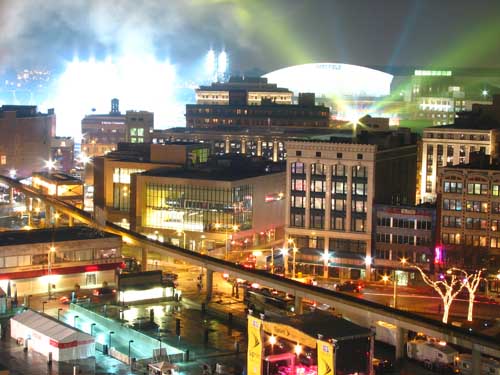 (Superbowl Night, 2006. Brand new Ford Field looms in the background. Photo Wiki Commons by ifmuth.)
(Superbowl Night, 2006. Brand new Ford Field looms in the background. Photo Wiki Commons by ifmuth.)
There is good stuff happening in Detroit; there must be. You can see some of it the picture above, from 2006. The downtown was spruced up for Super Bowl XL, when the Steelers cemented themselves as one of the great franchise in NFL history by beating the Seahawks at brand spanking new Ford Field, right downtown.
You can see from the image what the town looked like. Formula One driver Roger Penske worked on making the City glitter for the throngs who came. The new terminals at Detroit Metro Airport, the successor to Willow Run (The tri-graph for Metro is still “DTW”) were nearly ready, and Japanese and Chinese are heard as much as English on the new concourses since the place is an international hub.
The NFL joined in the civic boosterism, promoting this Super Bowl under the slogan “The Road to Forty.” The slogan not only honored the 40-year history of the game, but was a nod to Detroit’s traditional role as the center of the global auto industry. It was the first Superbowl to be played in the city. The only other time the NFL big-boys came to play was at the Pontiac Silverdome, way up in Auburn Hills.
The Lions left the city in 1975, just when I did. The getting was good that year, and antique Tiger Stadium did not have enough butts-in-seats for the voracious appetite of the NFL, and the Ford family, which had lost its way in the auto business and was mired in losing its way on the gridiron as well.
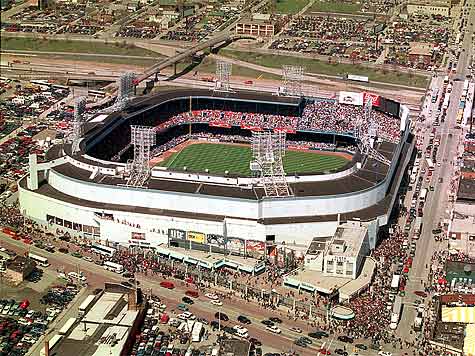
(Tiger Stadium on a game day. The place is gone, carted away in dumptrucks. Built in 1912, it was home to Big League baseball for nearly a century. Volunteers maintain the original diamond, though nothing else remains.)
1975 was a curious year, and intersected with the history of Oakland County, where the richer segment of white Detroit relocated, since it was 1975 when Pink Floyd called a hiatus to the performance of the hypnotic anthem “Dark Side of the Moon.” They did not perform it again, end-to-end, until 1994 in front of a sell-out crowd at the Silverdome in July of 1994. I was elsewhere then, but later, just before the turn of the millennium, attended a farewell of sorts to my then-father-in-law at the Detroit Athletic club. Ford Field was just rising then, and the rise of the new structure was accompanied by the demolition of the structures around the posh club that once had been the center of social life downtown, along with the Institute of Arts and the Opera House.
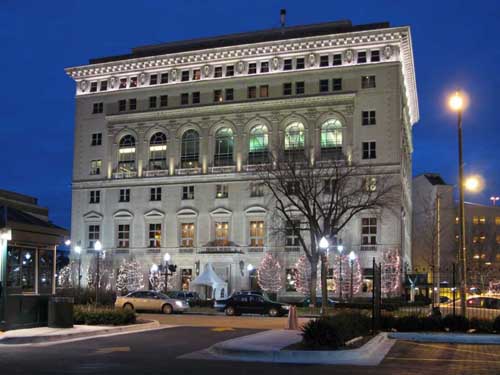
(Detroit Athletic Club at night, standing in proud isolation at 221 Madison. Since 1887, this was the club for Detroit’s elite. There is currently an incentive program designed to attract former members to re-join the club.)
The calculated demolition left the club looking like a white marble Chiclet in a gap-tooth grin.
A pal who is still in Grabbingham wrote to applaud my reminder that there is life in the old town still. It is part of the chip on all of our collective Diaspora shoulders about the people who come to gawk at the destruction of the old gal. But my pal had to note that if there is something good happening downtown, the people continue to flee the city.
My pal said it this way: “I have to admit there is something that really fuels the imagination in the near death of a city like Detroit. I drove down a couple weeks ago. The blight is much more visible now. I couldn’t tear myself away from looking at it. It was like drinking something you knew you shouldn’t, but getting high from it anyway.”
On the trip, my friend noted that just beyond the spruced up areas of downtown, the vistas become surreal. “Concrete covers every walkable surface. No trees are visible. Building materials are processed beyond recognition. Most of the inhabitants of this new world are strangely obese. Fast food is abundant. The center traffic lane of five has been taken over by shopping carts, pushed blindly by stoned shoppers. Its a new kind of blight, and its weird……very weird.”
The problem of the urban food desert- a phenomenon caused by the lack of supermarkets providing relatively wholesome food- is that available nourishment comes from the high-fat diet available from McDonald’s or Church’s Fried Chicken. There are strip malls replacing some of the old commercial areas, but what is available is not what is healthy, and as the city continues to empty out, it is as bizarre as what was Prussia in the wake of the passing of the Red Army.
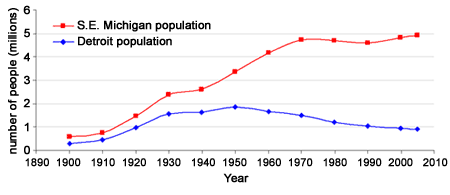
(Population of Southeastern Michigan. Data compiled and graph courtesy of the Large Lakes and Rivers Forecasting Research Branch, US EPA.)
Numbers don’t lie, though of course they can tell a variety of stories. The chart above demonstrates that Detroit did not die in a vacuum. The city just moved to the suburbs, and the vast infrastructure was recreated in the sprawl of the counties around the old urban areas.
With the population south of Eight Mile falling by half, it is not surprising that one of the great hobbies of those left behind was the annual Halloween arson festival perpetrated on abandoned buildings known as “Devils Night.”
There are some other troubling indicators that have come out of the 2010 Census. The Little City by the Bay Up North has seen the consequences of the downturn in Detroit. Tourism is down, and the Fudgies who come up to wander the summer streets and eat our confections don’t have as much cash to spread around and the demand for vacation properties has declined markedly. I would estimate that our place on the bluff has seen the price come down by as much as half; the grand McMansions at the sprawling Bay Harbor development at the old cement plant on Little Traverse Bay must have experienced the same thing.
It is no time to try to sell anything. Even downstate, the census reveals plush suburbs like my own Grabbingham are experiencing high vacancy rates. It is no secret to the Realtors that behind the well-maintained facades and manicured lawns no one is home.
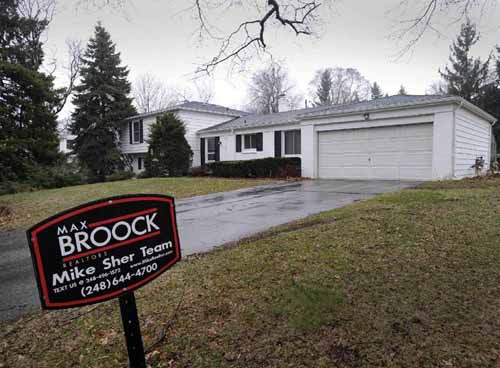
(Vacant house Bloomfield Township. The price was slashed to $135,000 from $340,000 after the sellers walked away from the mortgage. Photo Laura Berman.)
Grabbingham has a 9.4% vacancy rate, and regal Bloomfield Hills is over 10%. Those rates are similar to Detroit’s rate a decade ago, when the real flight accelerated, this time not just whites but blacks as well.
.
Where are they going? The overall population of the region is relatively stable, so it appears those who are staying are looking more closely at the old near-in suburbs like Ferndale and Royal Oak, where a small post-war home might be had for under a hundred grand.
The people in the property business seem to think it will be an interesting Spring, what with the Bankers getting the green light to resume foreclosures. It is almost tempting to think about relocating to take advantage of something grander than a two-bedroom apartment. But it will be great to visit the old town.
I am looking forward to taking in a Tigers game at Comerica Park, the new facility that replaced the old Tiger Field. It is really fancy, and serves as a magnet to bring people downtown.
But the blight is spreading all over. Remember the Silverdome? It cost the city of Pontiac nearly $57 million bucks in 1973-era money. That would be around $220 million in today’s tired greenbacks, and God knows what tomorrow, if you throw the cost of food and fuel in there, which curiously the government won’t do. Christ, even on base, premium fuel for the Hubrismobile hovered at $3.99 a gallon.
Anyway, after several innovative schemes to utilize the now-derelict stadium fell through, the city felt it had to get out from under the white elephant. They put it up for auction, and a Canadian name Andreas Apostolopoulos read about it in the paper. He put in a sealed bid and won it.
He paid $583,000 for the title to the place with 80,000 seats, 102 luxury sky-boxes and suites and premium 7,384 club seats. That is less than a lot of two bedroom apartments go for in DC, but hey, like they say, “Location, Location, location.”
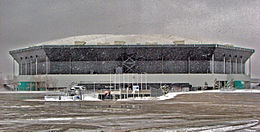
(Pontiac Silverdome, 2006. Photo Dave Hogg, Royal Oak, MI)
Copyright 2011 Vic Socotra
www.vicsocotra.com
